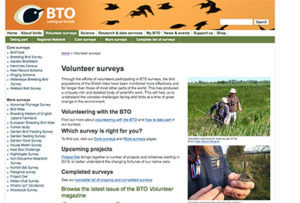Wetland Bird Survey (WeBS)
Monthly WeBS counts
of waterbirds.
Inland WeBS Tables
January-December 2024
January-December 2023
January-December 2022
January-December 2021
Jan-Mar, May-Dec 2020
January-December 2019
January-December 2018
January-December 2017
January-December 2016
January-December 2015
January-December 2014
January-December 2013
Coastal WeBS Tables
January-December 2024
January-December 2023
January-December 2022
January-December 2021
January-December 2020
January-December 2019
January-December 2018
January-December 2017
January-December 2016
January-December 2015
January-December 2014
January-December 2013
International Swan Census
» International Swan Census 2015
WeBS Counts in Northumberland
Wetland Bird Survey (WeBS) is the scheme which monitors non-breeding waterbirds in the UK. The principal aims of WeBS are to identify population sizes, determine trends in numbers and distribution and to identify important sites for waterbirds. Continuing a tradition begun in 1947, around 3,000 volunteer counters participate in synchronised monthly counts at wetlands of all habitat types, mainly during the winter period.
Monthly counts by volunteers are made on almost all the important wetlands in the UK, with most counts in the winter and the majority on specific dates. In Northumberland monthly counts are undertaken at the following ‘waterbodies’:
- up to 47 inland waters
- Lindisfarne NNR
- around 85km of open coastline, and
- at the county’s 5 major estuaries (Aln, Blyth, Coquet, Tweed and the Tyne)
The monthly counts in Northumberland involve up to 60 regular volunteer counters each month. At the moment all our sites have been ‘taken’ but if you would like to get involved at a future date please don’t hesitate to contact one of our two Local Organisers:
Inland Waters: Tim Daley Email: tim.birdman (at) gmail.com
Coastal and estuarine: Kathy Evans Email: kathyevans121 (at) gmail.com
WeBS is a partnership between the British Trust for Ornithology, the Royal Society for the Protection of Birds and the Joint Nature Conservation Committee (the latter on behalf of the Council for Nature Conservation and the Countryside, Natural Resources Wales, Natural England and Scottish Natural Heritage) in association with the Wildfowl and Wetlands Trust.
Breeding Bird Survey (BBS) and Waterways Breeding Bird Survey (WBBS)
The BTO/JNCC/RSPB Breeding Bird Survey is the main scheme for monitoring the changing
fortunes of the UK’s common breeding birds, generating population trends used to set
conservation priorities. In BBS, 1km squares are chosen randomly and cover all available
habitats, reflecting the percentage of land use in the area. WBBS routes follow waterways using similar recording methods to BBS.
After an initial reconnaissance visit in March to set up the transect routes, two early morning recording visits are required: ‘Early’ in April/May; ‘Late’ in late May/June, at least four weeks apart. All birds seen and heard should be recorded, as well as habitat details. There is also an optional mammal section to this. The object is to visit the site at the same time each year, or as close as possible, to enable comparisons to be made.
To find out more about both these surveys visit the British Trust for Ornithology’s BBS website at » www.bto.org/bbs
Breeding Bird Survey (BBS) – 2024
Although up to 100 squares have been surveyed at some time during the past 30 years a few sites have now become available due to retirements. Along with these, another 40 squares have also been assigned to Northumberland recently, leaving a long list of sites available.
There are 30 available squares in a range of habitats. To find out more go to www.bto.org/bbs
OR contact Muriel Cadwallender – tomandmurielcadwallender@hotmail.com
For a list of available squares » Click Here
BTO Winter Gull Survey (WinGS)
We need your help in Northumberland.
The Winter Gull Survey collects information about our wintering gull populations, through the coordinated effort of volunteer surveyors across the UK.
The 2023–2025 WinGS will involve one core count in January 2024 or 2025, at known major – ‘key’ – roost sites, most of which will have been covered by previous surveys. Key roost sites will include large estuaries, lakes and reservoirs.
Gulls will be counted as they arrive to roost at dusk, and volunteers (often working as part of a team) will record the five commonest gull species in the UK (Black- headed Gull, Common Gull, Lesser Black-backed Gull, Herring Gull and Great Black-backed Gull) as well as less numerous gull species.
To request sites, you will need to log in to the WinGS portal.
1. You will need a MyBTO account to log in to the WinGS portal. If you don’t already have one, you can create a MyBTO account now.
2. Visit the WinGS Vacant Site Map to view and request sites in your area.
3. The Key Date for 2024 surveys is January 21st.
4. Counts can be conducted a week before and after, as close to this key date as possible.
In winter, gulls flock together to roost communally on lakes, reservoirs and estuaries, in groups that can reach the thousands.
The Winter Gull Survey (WinGS) will run over the winters of 2023/24 and 2024/25 to collect updated information on the numbers and distributions of these wintering gulls in the UK, the Channel Islands and the Isle of Man.
Thanks for any help you can give.
Tom Cadwallender and Kathy Evans
(WinGS Coordinators for Northumberland)







